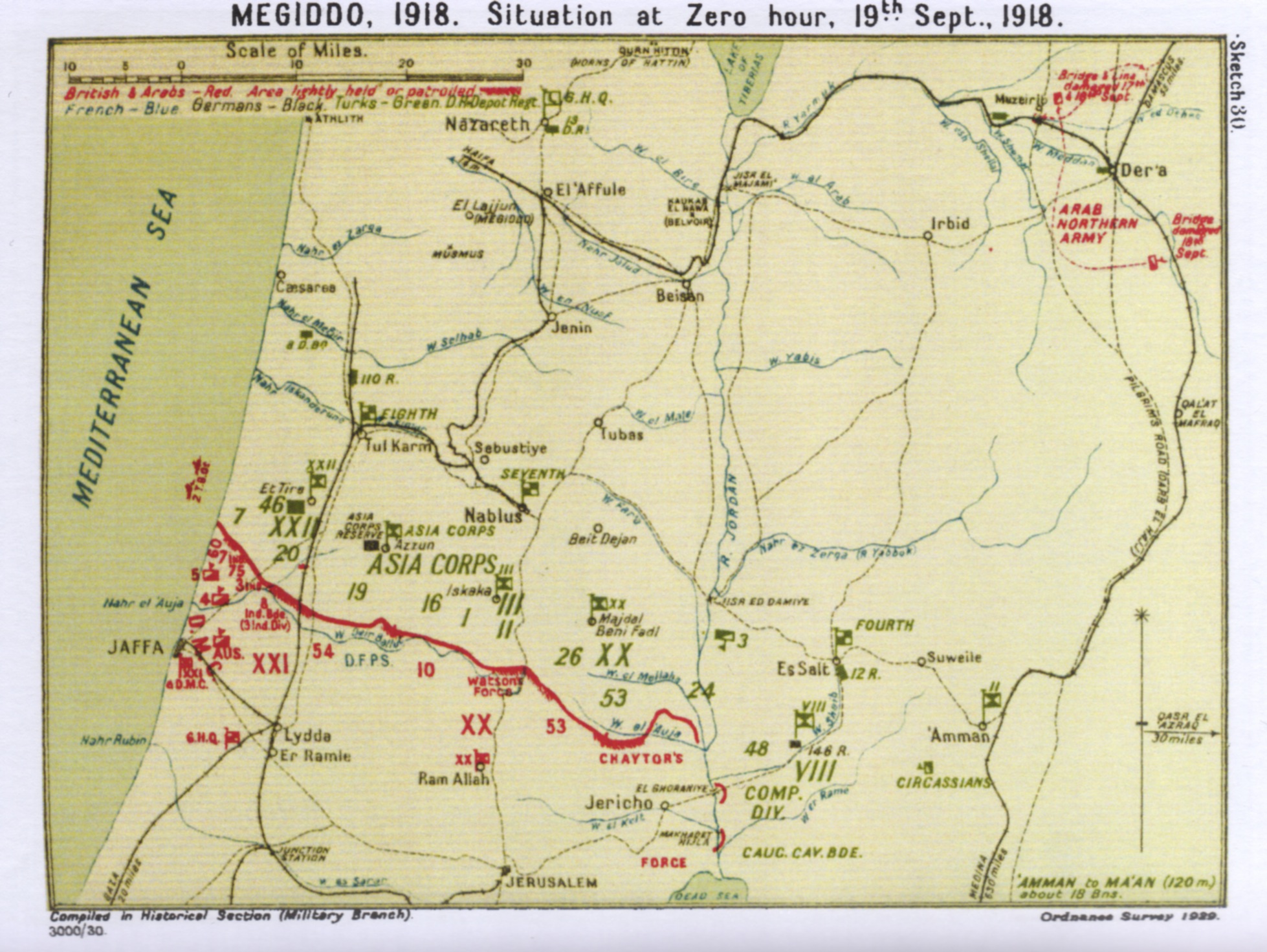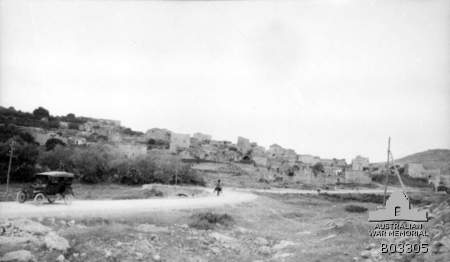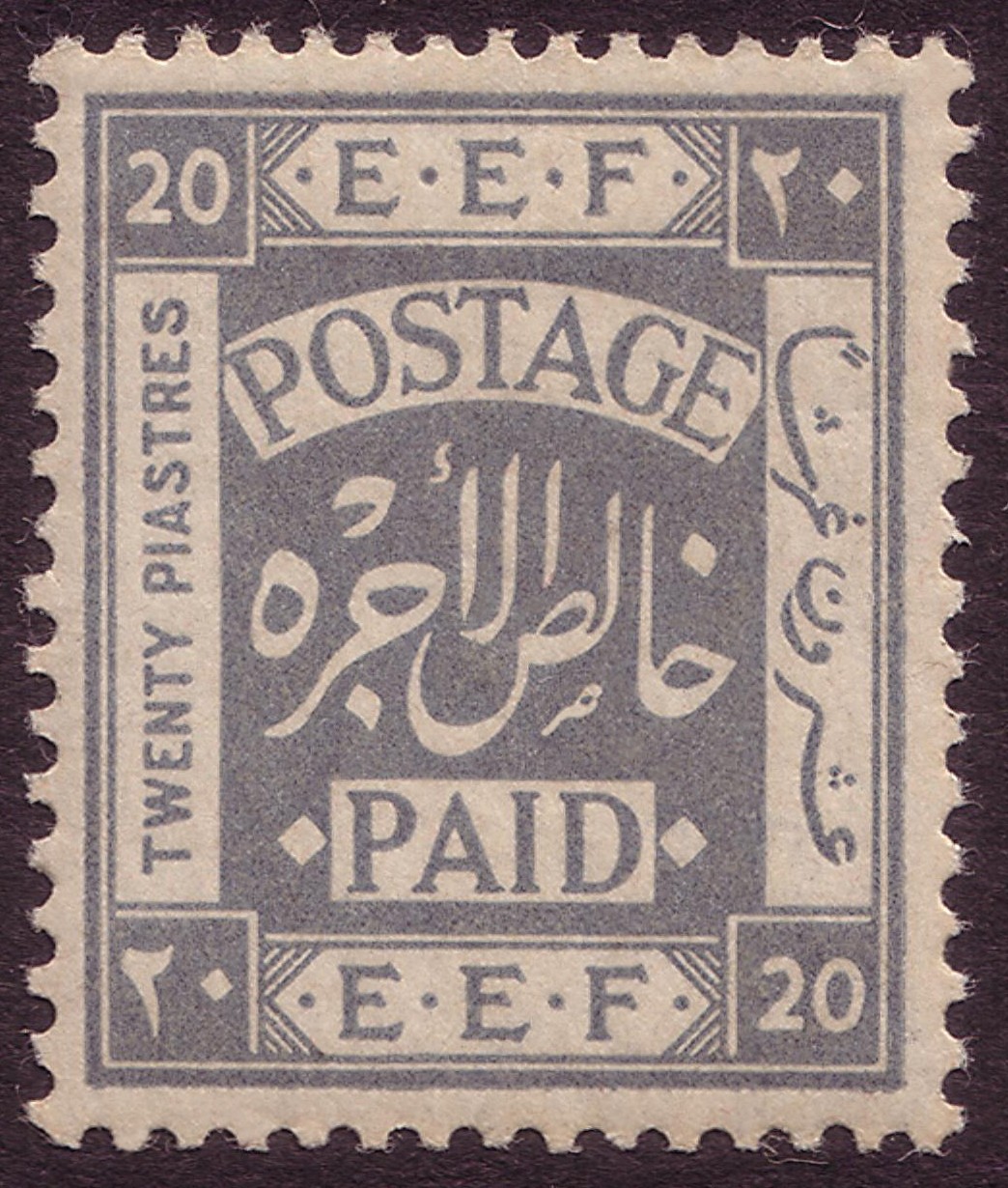|
Capture Of Jisr Ed Damieh
The Capture of Jisr ed Damieh took place on 22 September 1918 during the Third Transjordan attack of the Battle of Nablus which, along with the main Battle of Sharon formed the Battle of Megiddo fought during the Sinai and Palestine Campaign of the First World War. Units of Chaytor's Force under the commanded by Brigadier-General William Meldrum, and known as "Meldrum's Force", attacked and captured the bridge. This successful attack cut the most direct line of retreat from the Judean Hills for the Seventh and remnants of the Eighth Armies, while units from these two armies were moving towards, and crossing the Jisr ed Damieh bridge over the Jordan River. This victory by Meldrum's Force opened the way for Chaytor's Force to advance along the main Nablus to Es Salt road to capture Es Salt and to continue on to the victory at the Second Battle of Amman. The main attack by the Egyptian Expeditionary Force (EEF), commanded by General Edmund Allenby, during the battle of Sharon fo ... [...More Info...] [...Related Items...] OR: [Wikipedia] [Google] [Baidu] |
Middle Eastern Theatre Of World War I
The Middle Eastern theatre of World War I saw action between 29 October 1914 and 30 October 1918. The combatants were, on one side, the Ottoman Empire (including the majority of Kurdish tribes, a relative majority of Arabs, and Caucasian ''Tatars''), with some assistance from the other Central Powers; and on the other side, the British (with the help of Jews, Greeks, Assyrians, some Kurdish tribes, and many Arabs, along with Hindu and Muslim colonial troops from India), the Russians (with the help of Armenians, Assyrians, and occasionally some Kurdish tribes) and the French (with its North African and West African Muslim colonial troops) from among the Allied Powers. There were five main campaigns: the Sinai and Palestine Campaign, the Mesopotamian Campaign, the Caucasus Campaign, the Persian Campaign, and the Gallipoli Campaign. There were also several minor campaigns: Arab Campaign, and South Arabia Campaign. Both sides used local asymmetrical forces in the region. ... [...More Info...] [...Related Items...] OR: [Wikipedia] [Google] [Baidu] |
Battle Of Sharon
The Battle of Sharon fought between 19 and 25 September 1918, began the set piece Battle of Megiddo half a day before the Battle of Nablus, in which large formations engaged and responded to movements by the opposition, according to pre-existing plans, in the last months of the Sinai and Palestine Campaign of World War I. The fighting took place over a wide area from the Mediterranean Sea east to the Rafat salient in the Judean Hills. Here the Egyptian Expeditionary Force (EEF) XXI Corps with the French brigade sized '' Détachement Français de Palestine et de Syrie'' attacked the Yildirim Army Group Eighth Army's XXII Corps and German Asia Corps. The Battle of Sharon extended well behind the Ottoman front lines when the Desert Mounted Corps rode through a gap in the front line across the Plain of Sharon to occupy the Esdraelon Plain. Meanwhile, during the Battle of Nablus the XX Corps attacked Nablus while Chaytor's Force held the right flank in the Jordan Valley befor ... [...More Info...] [...Related Items...] OR: [Wikipedia] [Google] [Baidu] |
Battle Of Tabsor (1918)
The Battle of Tabsor was fought on 19–20 September 1918 beginning the Battle of Sharon, which along with the Battle of Nablus formed the set piece Battle of Megiddo fought between 19 and 25 September in the last months of the Sinai and Palestine Campaign of the First World War. During the infantry phase of the Battle of Sharon the British Empire 60th Division, XXI Corps attacked and captured the section of the front line nearest the Mediterranean coast under cover of an intense artillery barrage including a creeping barrage and naval gunfire. This Egyptian Expeditionary Force (EEF) victory over the entrenched Ottoman Eighth Army, composed of German and Ottoman soldiers, began the Final Offensive, ultimately resulting in the destruction of the equivalent of one Ottoman army, the retreat of what remained of two others, and the capture of many thousands of prisoners and many miles of territory from the Judean Hills to the border of modern-day Turkey. After the end of the ba ... [...More Info...] [...Related Items...] OR: [Wikipedia] [Google] [Baidu] |
Battle Of Tulkarm (1918)
The Battle of Tulkarm took place on 19 September 1918, beginning of the Battle of Sharon, which along with the Battle of Nablus (1918), Battle of Nablus formed the set piece Battle of Megiddo (1918), Battle of Megiddo fought between 19 and 25 September in the last months of the Sinai and Palestine Campaign of the First World War. During the infantry phase of the Battle of Sharon the British Empire 60th (2/2nd London) Division, 60th Division, XXI Corps (United Kingdom), XXI Corps attacked and captured the section of the front line nearest the Mediterranean coast under cover of an intense artillery barrage including a creeping barrage and naval gunfire. This Egyptian Expeditionary Force (EEF) victory over the entrenched Eighth Army (Ottoman Empire), Ottoman Eighth Army, composed of German Empire, German and Ottoman Empire, Ottoman soldiers, began the Final Offensive, ultimately resulting in the destruction of the equivalent of one Military of the Ottoman Empire, Ottoman army, the re ... [...More Info...] [...Related Items...] OR: [Wikipedia] [Google] [Baidu] |
XXI Corps (United Kingdom)
The XXI Corps was an Army Corps of the British Army during World War I. The Corps was formed in Palestine in August 1917 under the command of Lieutenant General Edward Bulfin.Woodward, p 100 It formed part of the Egyptian Expeditionary Force (EEF) and served in the Sinai and Palestine Campaign. At the Battle of Sharon it fought what has been described as 'one of the most overwhelmingly successful operations of the war' and 'a precursor to the modern ''Blitzkrieg''.' It then carried out remarkable march up the coast of modern-day Lebanon as the war came to an end. Origin When General Sir Edmund Allenby took over command of the Egyptian Expeditionary Force (EEF) in Palestine in the Summer of 1917 he completely reorganised it. XXI Corps Headquarters was formed on 12 August at Deir al-Balah to take responsibility for the left section of the EEF's line in front of Gaza City, including 52nd (Lowland), 54th (East Anglian) and 75th Divisions and three brigades of heavy artillery. It ... [...More Info...] [...Related Items...] OR: [Wikipedia] [Google] [Baidu] |
Edmund Allenby
Field Marshal Edmund Henry Hynman Allenby, 1st Viscount Allenby, (23 April 1861 – 14 May 1936) was a senior British Army officer and Imperial Governor. He fought in the Second Boer War and also in the First World War, in which he led the British Empire's Egyptian Expeditionary Force (EEF) during the Sinai and Palestine Campaign against the Ottoman Empire in the conquest of Palestine. The British succeeded in capturing Beersheba, Jaffa, and Jerusalem from October to December 1917. His forces occupied the Jordan Valley during the summer of 1918, then went on to capture northern Palestine and defeat the Ottoman Yildirim Army Group's Eighth Army at the Battle of Megiddo, forcing the Fourth and Seventh Army to retreat towards Damascus. Subsequently, the EEF Pursuit by Desert Mounted Corps captured Damascus and advanced into northern Syria. During this pursuit, he commanded T. E. Lawrence (''"Lawrence of Arabia"''), whose campaign with Faisal's Arab Sherifial Forces as ... [...More Info...] [...Related Items...] OR: [Wikipedia] [Google] [Baidu] |
General (United Kingdom)
General (or full general to distinguish it from the lower general officer ranks) is the highest rank achievable by serving officers of the British Army. The rank can also be held by Royal Marines officers in tri-service posts, for example, General Sir Gordon Messenger the former Vice-Chief of the Defence Staff (United Kingdom), Vice-Chief of the Defence Staff. It ranks above Lieutenant-general (United Kingdom), lieutenant-general and, in the Army, is subordinate to the rank of Field marshal (United Kingdom), field marshal, which is now only awarded as an honorary rank. The rank of general has a NATO-code of OF-9, and is a four-star rank. It is equivalent to a Admiral (Royal Navy), full admiral in the Royal Navy or an air chief marshal in the Royal Air Force. Officers holding the ranks of lieutenant-general and Major-general (United Kingdom), major-general may be generically considered to be generals. Insignia A general's insignia is a crossed sword and baton. This appeared o ... [...More Info...] [...Related Items...] OR: [Wikipedia] [Google] [Baidu] |
Egyptian Expeditionary Force
The Egyptian Expeditionary Force (EEF) was a British Empire military formation, formed on 10 March 1916 under the command of General Archibald Murray from the Mediterranean Expeditionary Force and the Force in Egypt (1914–15), at the beginning of the Sinai and Palestine Campaign of the First World War. History Formed in the British protectorate of the Sultanate of Egypt, the initially small force was raised to guard the Suez Canal and Egypt. After the withdrawal from the Gallipoli Campaign the force grew into a large reserve to provide reinforcements for the Western Front (World War I), Western Front, while the Western Frontier Force fought in the Senussi Campaign from 1915 to 1917 and the Eastern Force (EF) defended the canal at the Battle of Romani in August 1916. Following the victory at Romani, part of the Eastern Force pursued the Ottoman Empire, Ottoman invading force back to Palestine (region), Palestine after the victories at the Battle of Magdhaba in December 1916 and t ... [...More Info...] [...Related Items...] OR: [Wikipedia] [Google] [Baidu] |
Second Battle Of Amman
The Second Battle of Amman was fought on 25 September 1918 during the Third Transjordan attack as part of the Battle of Nablus which together with the main Battle of Sharon form the major set piece offensive known as the Battle of Megiddo of the Sinai and Palestine Campaign in World War I. After cutting the road from Nablus to Es Salt on 22 September Chaytor's Force captured the bridge over the Jordan River at Jisr ed Damieh while units of the Seventh Army and remnants of the Eighth Army were still in retreating towards the bridge from the Judean Hills. Having cut this line of retreat, Chaytor's Force proceeded eastwards to attack and capture Es Salt, before riding on to attack and capture the Ottoman rearguard of the Fourth Army defending Amman. These British Empire victories of the Third Transjordan attack over Yildirim Army Group forces, followed two unsuccessful EEF attacks across the Jordan River in March and April 1918. The Egyptian Expeditionary Force (EEF), comma ... [...More Info...] [...Related Items...] OR: [Wikipedia] [Google] [Baidu] |
Salt, Jordan
Al-Salt ( ar, السلط ''As-Salt'') is an ancient salt trading city and administrative centre in west-central Jordan. It is on the old main highway leading from Amman to Jerusalem. Situated in the Balqa highland, about 790–1,100 metres above sea level, the city is built in the crook of three hills, close to the Jordan Valley. One of the three hills, Jabal al-Qal'a, is the site of a 13th-century ruined fortress. It is the capital of Balqa Governorate. The Greater Salt Municipality has about 107,874 inhabitants (2018). Al-Salt was added to the UNESCO World Heritage list in 2021. History It is not known when the city was first inhabited, but it is believed that it was built by the Macedonian army during the reign of Alexander the Great. The city was known as Saltus in Byzantine times and was the seat of a bishopric. At this time, the city was considered to be the principal settlement on the East Bank of the Jordan River. The settlement was destroyed by the Mongols and ... [...More Info...] [...Related Items...] OR: [Wikipedia] [Google] [Baidu] |
Jordan River
The Jordan River or River Jordan ( ar, نَهْر الْأُرْدُنّ, ''Nahr al-ʾUrdunn'', he, נְהַר הַיַּרְדֵּן, ''Nəhar hayYardēn''; syc, ܢܗܪܐ ܕܝܘܪܕܢܢ ''Nahrāʾ Yurdnan''), also known as ''Nahr Al-Sharieat'' ( ar, نهر الشريعة), is a river in the Middle East that flows roughly north to south through the Sea of Galilee (Hebrew: כנרת Kinneret, Arabic: Bohayrat Tabaraya, meaning Lake of Tiberias) and on to the Dead Sea. Jordan and the Golan Heights border the river to the east, while the West Bank and Israel lie to its west. Both Jordan and the West Bank take their names from the river. The river holds major significance in Judaism and Christianity. According to the Bible, the Israelites crossed it into the Promised Land and Jesus of Nazareth was baptized by John the Baptist in it. Geography The Jordan River has an upper course from its sources to the Sea of Galilee (via the Bethsaida Valley), and a lower course south of ... [...More Info...] [...Related Items...] OR: [Wikipedia] [Google] [Baidu] |
Eighth Army (Ottoman Empire)
The Eighth Army of the Ottoman Empire ( Turkish: ''Sekizinci Ordu'') was one of the field armies of the Ottoman Army. It was established during World War I. World War I In June 1917, Enver Paşa activated the Yildirim Army Group (also known as Thunderbolt Army Group) commanded by the German General Erich von Falkenhayn, and reinforced it with surplus Ottoman units transferred from Galicia, Romania, and Thrace.Erickson ''Ordered to Die: A History of the Ottoman Army in the First World War'', Greenwood Press, 2001, , pp. 159, 171, ''Ottoman Army Effectiveness in World War I: a comparative study'' Routledge Press, 2007, p. 115 Following the formation of the Yildirim Army Group substantial forces were deployed to Syria and Palestine, where they continued to hold the Fourth Army defenses. Already in Palestine were the 3rd, 7th, 16th, and 54th Infantry Divisions while the 26th 27th, and 53rd Infantry Divisions arrived during the summer. The 3rd, 7th 16th, and 26th Infantry Divisio ... [...More Info...] [...Related Items...] OR: [Wikipedia] [Google] [Baidu] |








